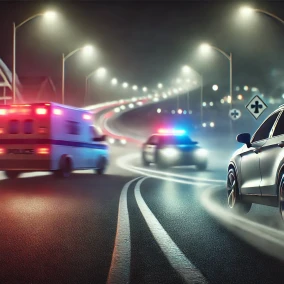The Dangers of Drunk Driving
Alcohol
Drinking and driving is a serious issue. Each year, over 15,000 people in the US are killed in alcohol-related traffic accidents, accounting for over 40% of all fatalities on US roadways. Despite the well-known dangers of driving under the influence, thousands of people drive under the influence of alcohol or other substances daily, putting themselves and others at risk.
Many people mistakenly believe that only the severely drunk will be involved in accidents. However, a significant percentage of accidents involve those who have only had a few drinks—enough to impair reaction time and cause accidents.
We often underestimate how much our reaction time affects driving. Losing even a quarter-second of reaction time can mean the difference between avoiding a potential accident and causing one.
Statistics on Drunk Driving
- Vehicular Trips: Every year, over 159 million vehicular trips are made by drivers under the influence. Astoundingly, over 10% of these trips are made by underage drinkers. While most of these trips may not result in incidents, the sheer number highlights the potential for harm.
- Accident Involvement: About 30% of Americans will be involved in an alcohol-related accident at some point. While many of these accidents may be minor, causing only a few bumps and bruises, the risk of serious, life-threatening accidents is ever-present. Many of us know someone affected by drunk driving, and some have lost friends or family members to these preventable incidents.
- DUI Arrests: On average, a person drives drunk 87 times before their first DUI arrest. This statistic highlights the challenge law enforcement faces in catching drunk drivers. Many manage to drive under the influence without incident, which can embolden them to continue this dangerous behavior until they are finally stopped by the police. The critical question is whether they will cause an accident before being caught.
- DUI Arrest Rate: Only 1 out of 139 drivers will be arrested for DUI in the US each year. While this may seem like a small number, it translates to 1.46 million people being arrested, jailed, and having their licenses suspended. The consequences of a DUI conviction can be severe, including fines up to $20,000 for first-time offenders, which can significantly impact their lives and livelihoods.
- Economic Costs: Alcohol-related accidents cost the public an estimated $114.3 billion annually. This figure includes insurance and repair bills, property damage, hospital stays, funeral expenses, and more. Astonishingly, 63% of the cost of an accident involving a drunk driver is borne by the victims or their families.
- Nighttime Fatal Crashes: Fatal crashes involving alcohol are four times more likely to happen at night. Nighttime driving already presents challenges due to restricted vision, and alcohol further impairs a driver’s ability to react, increasing the likelihood of fatal accidents.
- Annual Fatalities: Each year, an estimated 15,000 people die in alcohol-related vehicular accidents in the US. Alcohol is involved in over 40% of all traffic fatalities. Every 39 minutes, a drunk driver either dies or takes the life of another person in an accident that could have been avoided if the driver had not been under the influence.
Trends and Cultural Shifts
- Average Drinking Age: The average age at which a person starts drinking has decreased since 1965, despite the legal drinking age increasing in many states. This trend may reflect broader cultural shifts, including increased social acceptance of underage drinking, greater availability of alcohol, and changing societal norms around alcohol consumption. This decrease in the average drinking age contributes to the number of individuals who may drive under the influence.
- Social Attitudes Towards Drinking and Driving: There has been a shift in public awareness and attitudes towards drinking and driving over the years. Campaigns such as "Don't Drink and Drive" and initiatives by organizations like Mothers Against Drunk Driving (MADD) have raised awareness about the dangers of drunk driving. Despite these efforts, a significant number of people still engage in this risky behavior, indicating that while awareness has increased, compliance and behavioral change have been slower to follow.
- Legal and Policy Changes: Over the decades, there have been numerous changes in laws and policies aimed at reducing drunk driving. These include lower legal blood alcohol concentration (BAC) limits, increased penalties for DUI offenses, and the introduction of sobriety checkpoints. Such measures have been effective in reducing the incidence of drunk driving, but ongoing efforts are needed to ensure these policies are enforced and updated as needed.
- Technology and Prevention: Advances in technology have also influenced trends in drunk driving. For instance, the development and implementation of ignition interlock devices, which prevent a vehicle from starting if the driver's BAC is above a certain level, have proven effective in reducing repeat offenses. Additionally, ride-sharing apps like Uber and Lyft provide convenient alternatives to driving under the influence, potentially reducing the incidence of drunk driving.
- Cultural Shifts: Cultural shifts towards health and wellness have also impacted drinking behaviors. There is a growing trend towards moderation and mindfulness in alcohol consumption, particularly among younger generations who are more health-conscious. This cultural shift may contribute to a decline in drunk driving incidents as more people choose to drink responsibly or abstain from alcohol altogether.
In today's world, there are numerous alternatives to prevent drunk driving, such as calling a taxi, selecting a designated driver, or arranging for responsible drinking conditions. However, many people who drink do not take these precautions or mistakenly believe that a few drinks do not impair their ability to drive. The sobering statistics of drinking and driving underscore the need for significant cultural changes to reduce these preventable tragedies.
